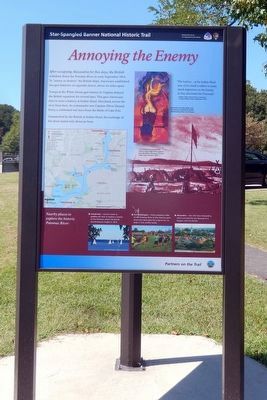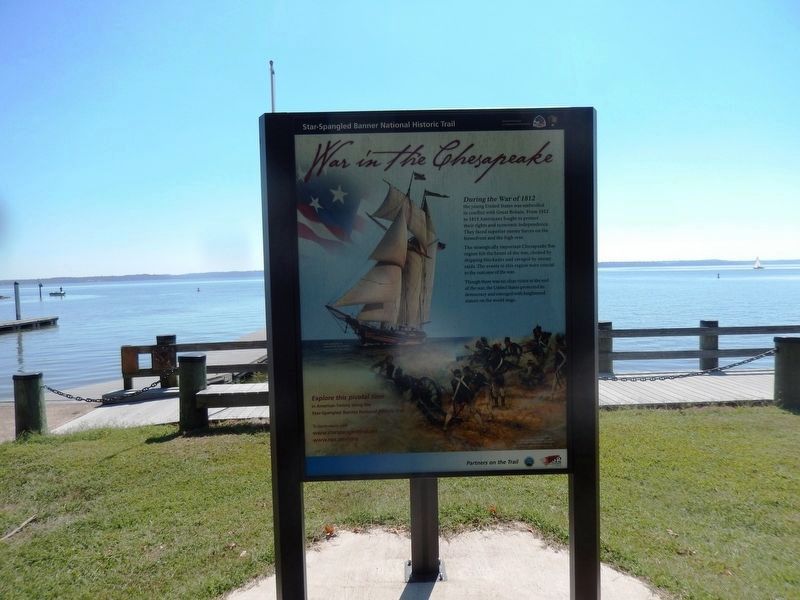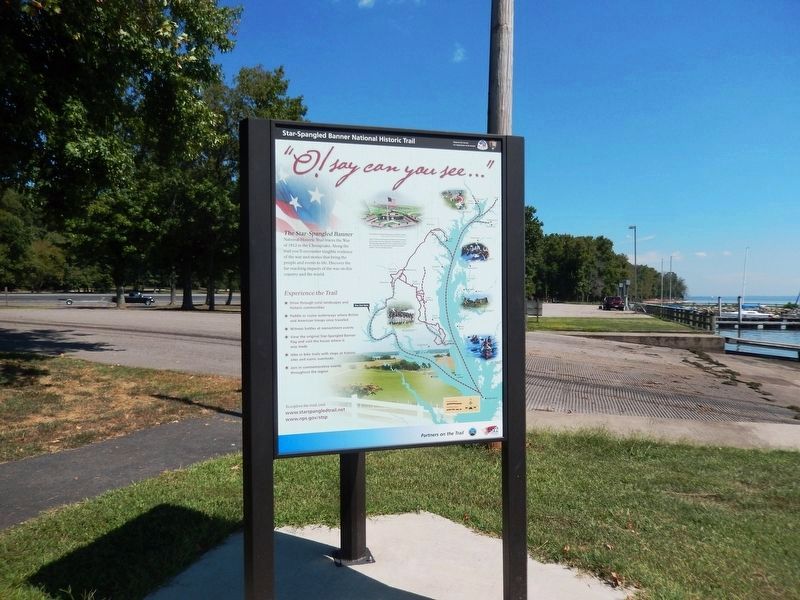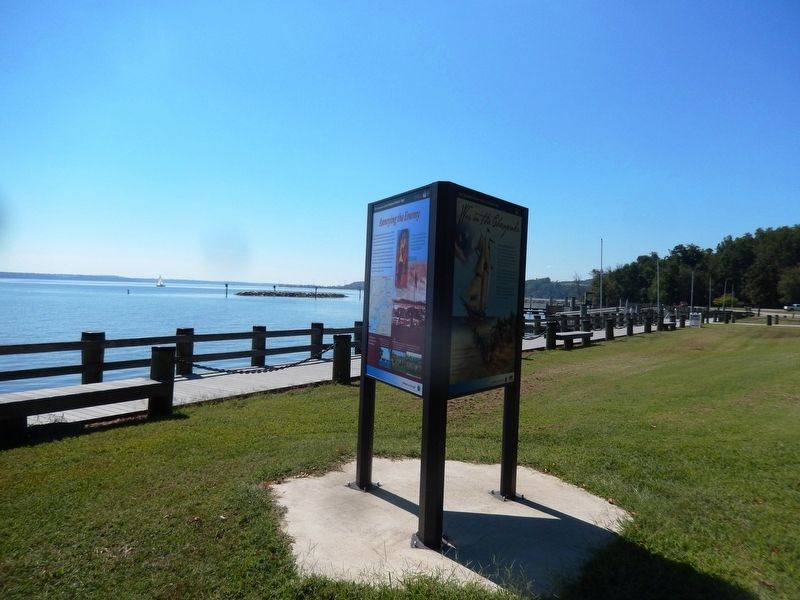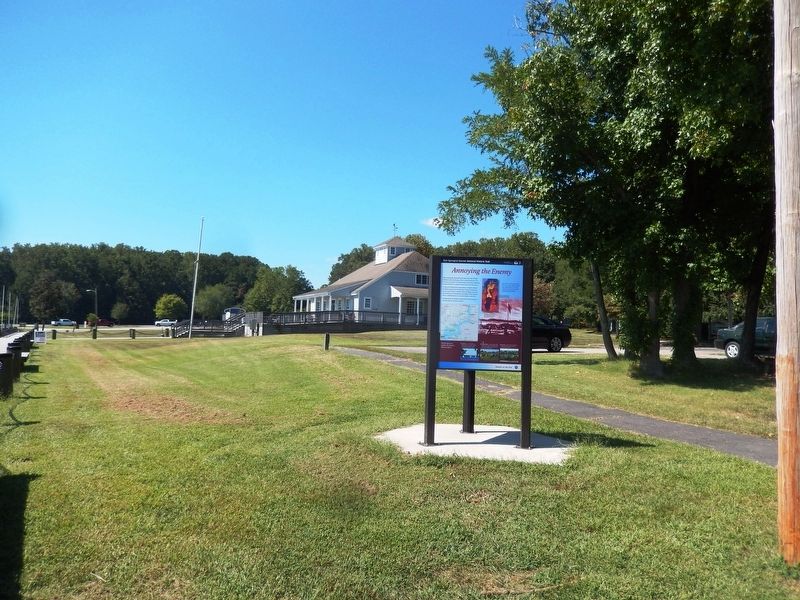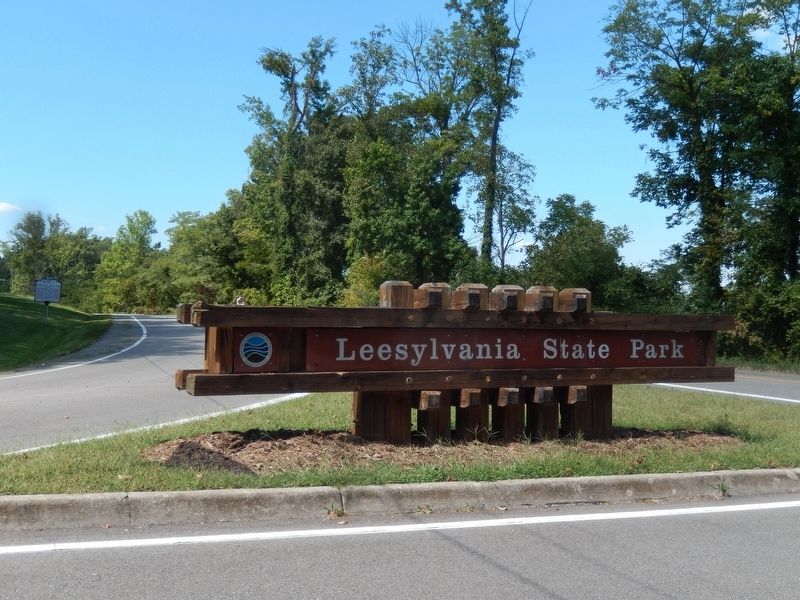Leesylvania in Prince William County, Virginia — The American South (Mid-Atlantic)
Annoying the Enemy
Star-Spangled Banner National Historic Trail
— National Park Service, U.S. Department of the Interior —
After occupying Alexandria for five days, the British withdrew down the Potomac River in early September 1814. To “annoy or destroy” the British ships, Americans established two gun batteries on opposite shores, about six miles apart.
Troops at the White House gun battery in Virginia delayed the British squadron for several days. This gave Americans time to erect a battery at Indian Head, Maryland, across the river from here. Its commander was Captain Oliver Hazard Perry, a celebrated war hero from the Battle of Lake Erie.
Outmatched by the British at Indian Head, the exchange of fire there lasted only about an hour.
“The battery… at the Indian Head was of too small a caliber to make much impression on the Enemy as they descended the Potomak.”
- Captain Oliver Hazard Perry to Secretary of Navy William Jones, September 9, 1814
(caption)
Americans set ships ablaze and sent them to impede the British withdrawing down the Potomac
Late 19th century drawing by William Bainbridge Hoff suggests how the White House gun battery might have looked in 1814.
(sidebar)
Nearby places to explore the historic Potomac River:
• Leesylvania - Launch a boat or paddlecraft here to explore a stretch of the Potomac where the British and Americans fought in 1814.
• Fort Washington - Enjoy sweeping views of the Potomac River at this national park. Americans destroyed the original fort to keep it from enemy hands.
• Alexandria - Visit Old Town Alexandria, which survived the war because of a bargain with the British.
(Panel 2)
War in the Chesapeake
During the War of 1812 the young United States was embroiled in conflict with Great Britain. From 1812 to 1815 Americans fought to protect their rights and economic independence. They faced superior enemy forces on the homefront and the high seas.
The strategically important Chesapeake Bay region felt the brunt of the war, choked by shipping blockades and ravaged by enemy raids. The events in this region were crucial to the outcome of the war.
Though there was no clear victor at the end of the war, the United States protected its democracy and emerged with heightened stature on the world stage.
Explore this pivotal time in American history along the Star-Spangled Banner National Historic Trail
(Panel 3)
"O! say can you see..."
The Star-Spangled Banner National Historic Trail traces the War of 1812 in the Chesapeake. Along the trail you'll encounter tangible evidence of the war and stories that bring the people and events to life. Discover the far-reaching impacts of the war on this country and the world.
Experience the Trail
• Drive through rural landscapes and historic communities
• Paddle or cruise waterways where British and American troops once traveled
• Witness battles at reenactment events
• View the original Star-Spangled Banner flag and visit the house where it was made
• Hike or bike trails with stops at historic sites and scenic overlooks
• Join in commemorative events throughout the region
(caption)
Fort McHenry National Monument and Historic Shrine
After a 25-hour bombardment, soldiers at Fort McHenry raised a large American flag early on September 14, 1814. That flag, signaling British retreat, inspired Francis Scott Key to pen the words that became America's national anthem, The Star-Spangled Banner
Erected by National Park Service, U.S. Department of the Interior.
Topics. This historical marker is listed in these topic lists: War of 1812 • Waterways & Vessels. A significant historical date for this entry is September 9, 1814.
Location. 38° 35.23′ N, 77° 15.301′ W. Marker is in Leesylvania, Virginia, in Prince William County. Marker is on Daniel K Ludwig Drive, 1.9 miles south of Neabsco Road, on the right when traveling east. The marker is located in Leesylvania State Park near the marina store. Touch for map. Marker is at or near this postal address: 2201 Daniel K Ludwig Drive, Woodbridge VA 22191, United States of America. Touch for directions.
Other nearby markers. At least 8 other markers are within walking distance of this marker. War in the Chesapeake (a few steps from this marker); Pollution Solution (about 600 feet away, measured in a direct line); Seasonal Encampments (approx. 0.2 miles away); Mill Wheel (approx. ¼ mile away); “Pleasureland of the East” (approx. 0.3 miles away); Swimming in Bounty (approx. 0.4 miles away); The Freestone Fisheries (approx. 0.4 miles away); Iron Pulley Wheel (approx. 0.4 miles away). Touch for a list and map of all markers in Leesylvania.
Credits. This page was last revised on December 5, 2023. It was originally submitted on September 24, 2016, by Don Morfe of Baltimore, Maryland. This page has been viewed 274 times since then and 14 times this year. Last updated on December 5, 2023, by N. Jozsa of Woodbridge, Virginia. Photos: 1, 2, 3, 4, 5, 6. submitted on September 24, 2016, by Don Morfe of Baltimore, Maryland. • Bernard Fisher was the editor who published this page.
